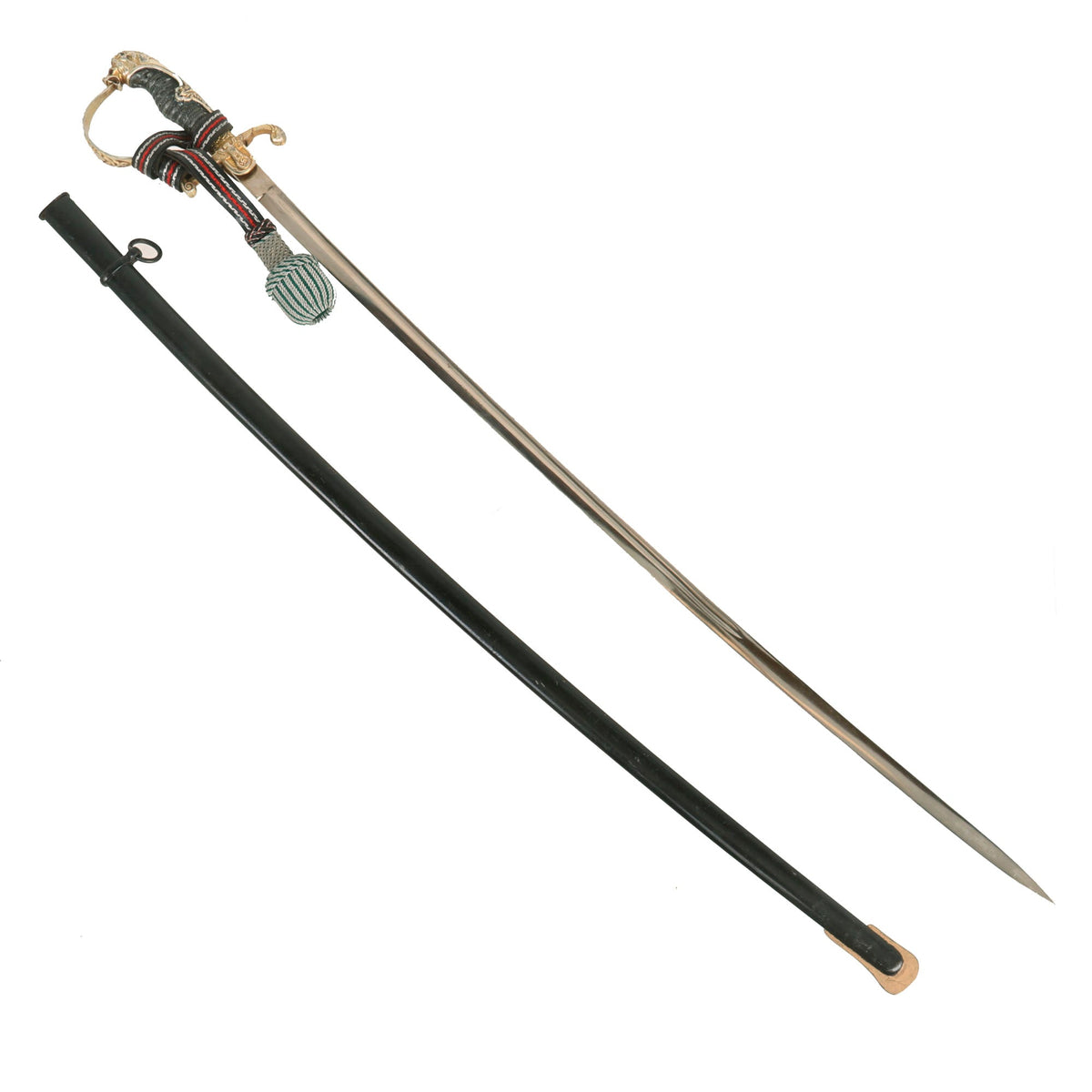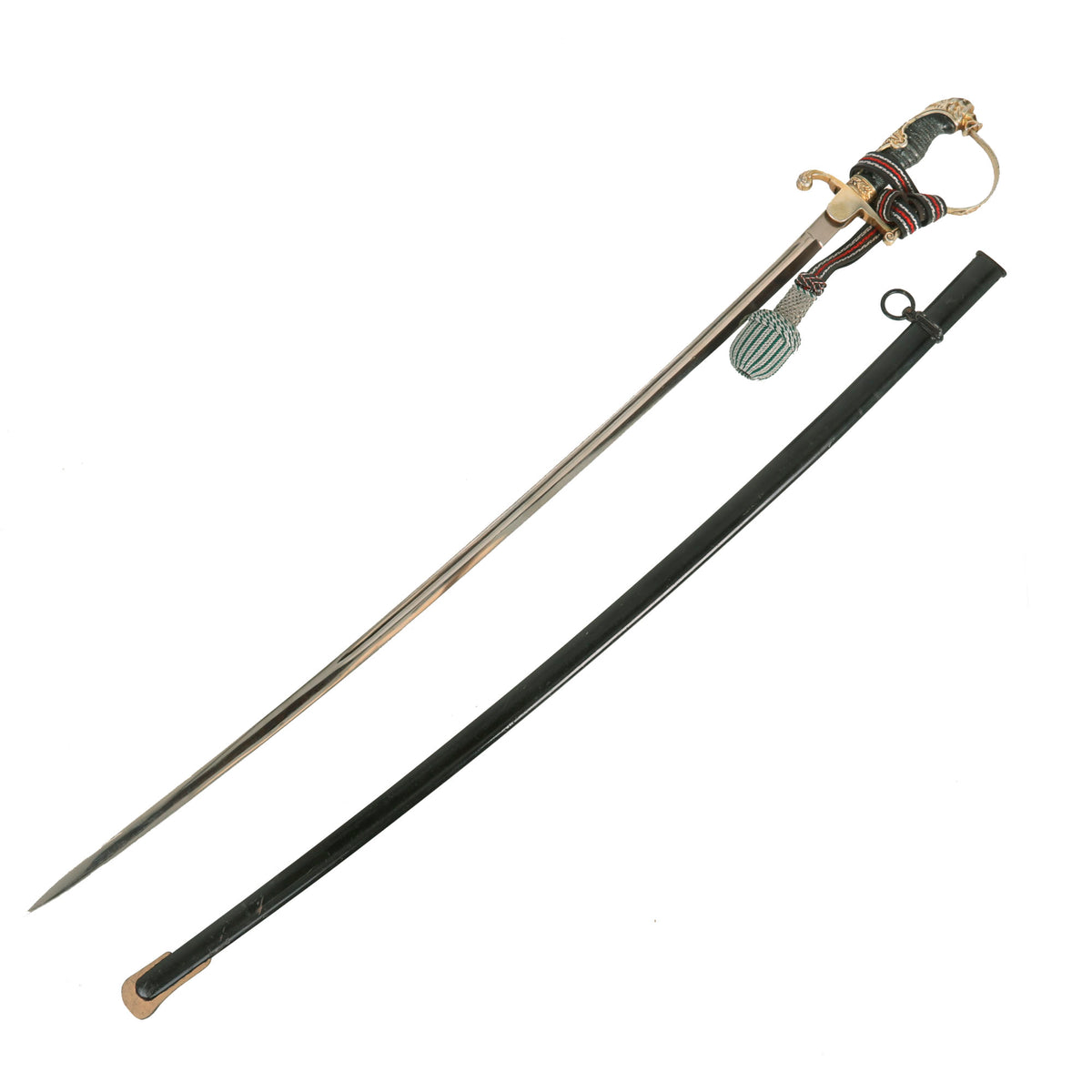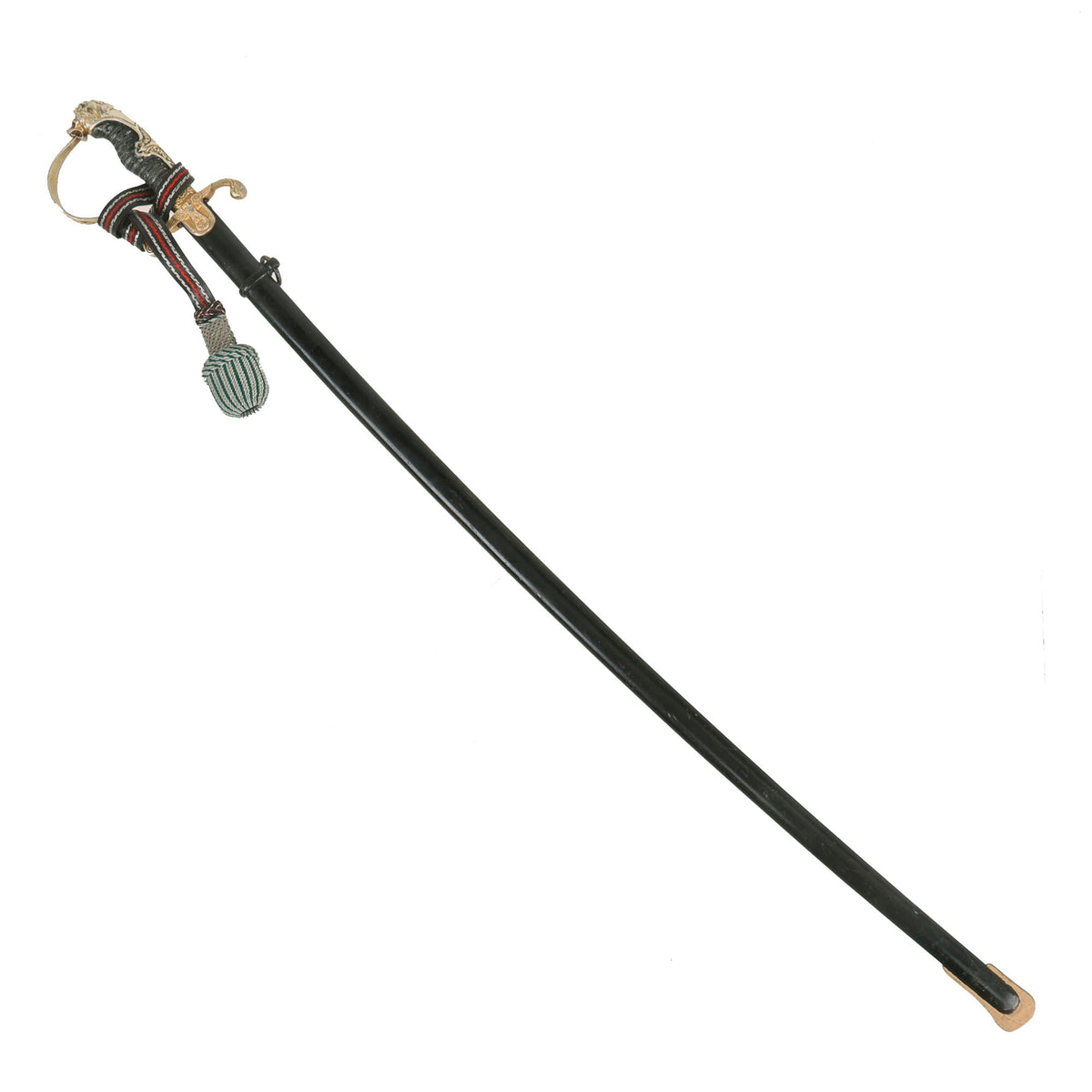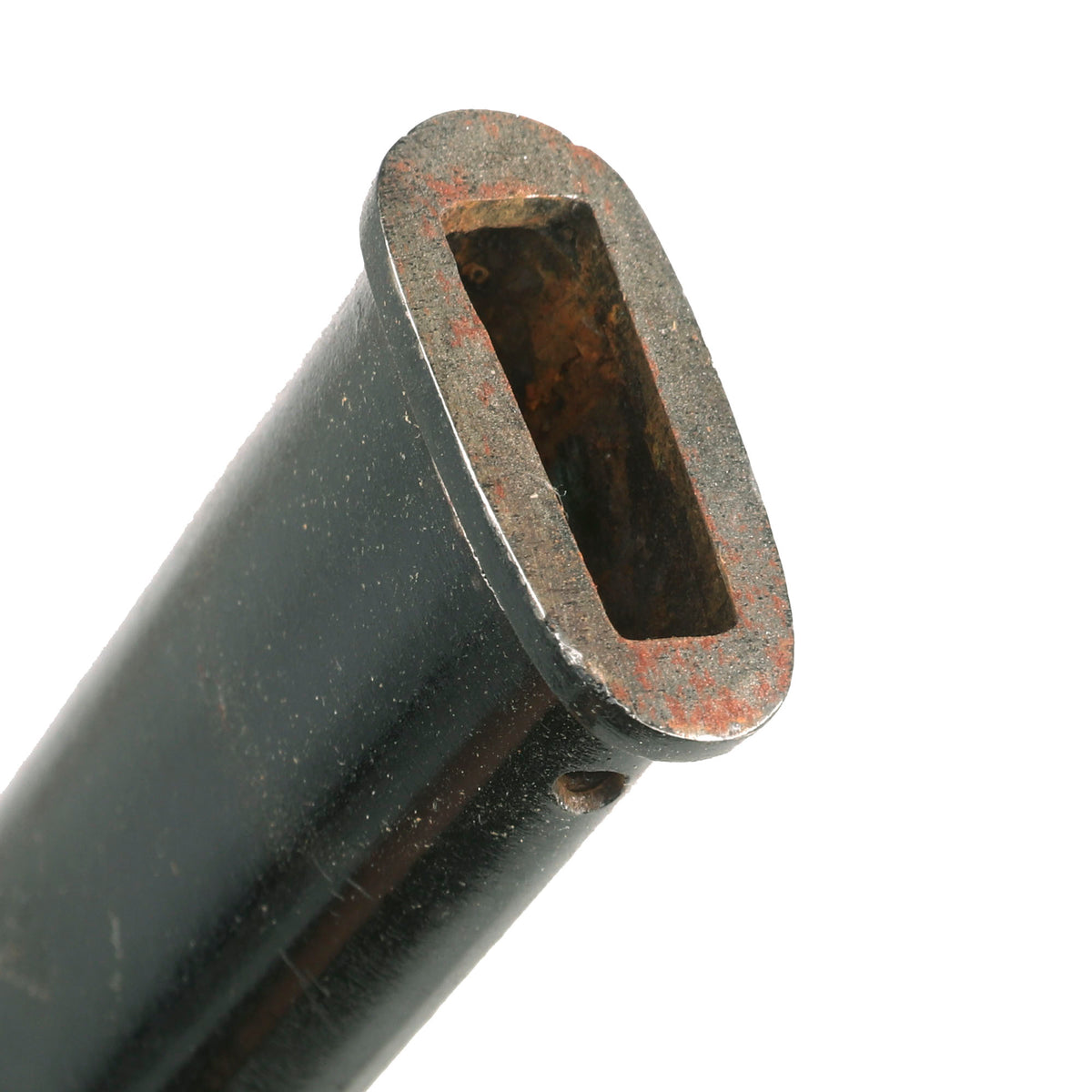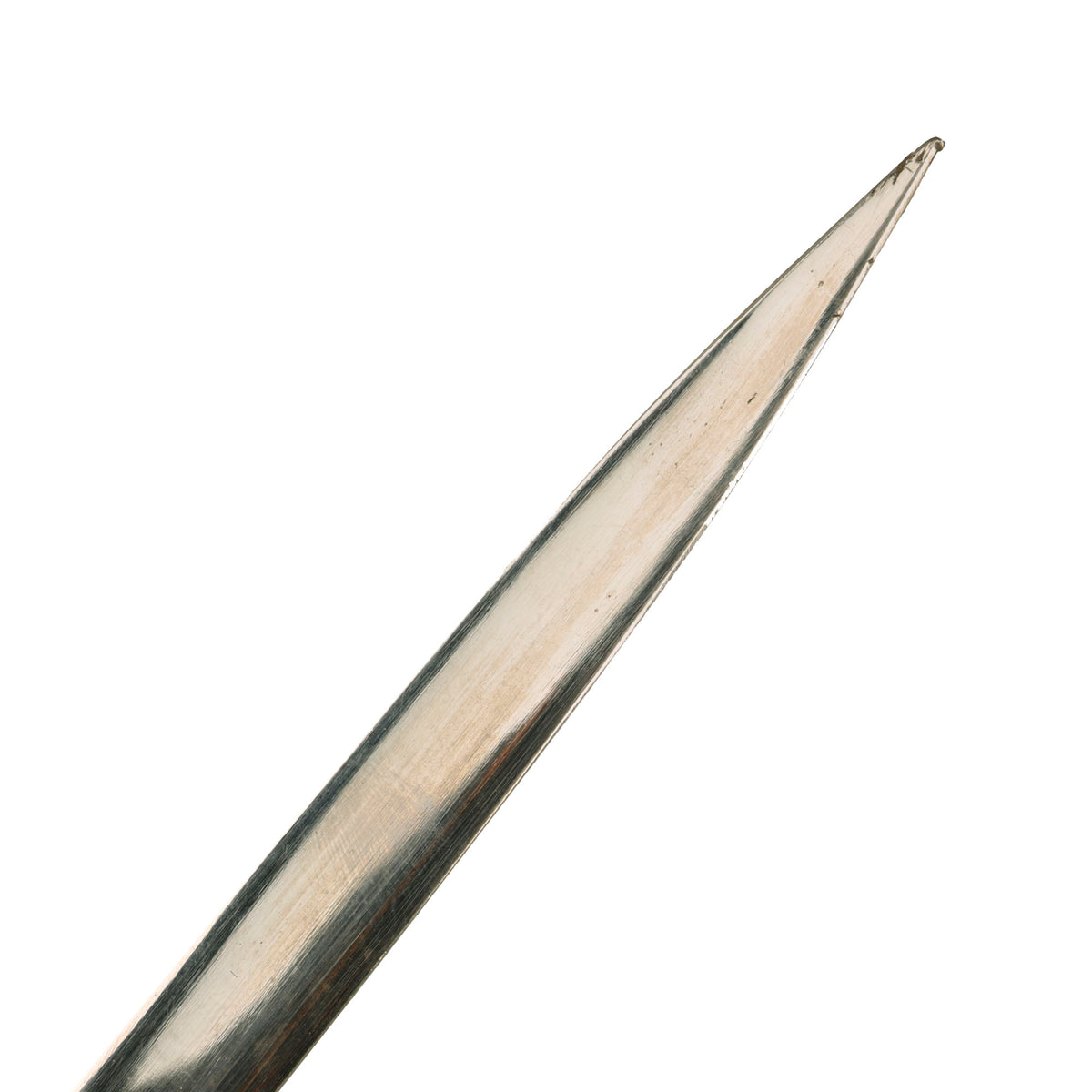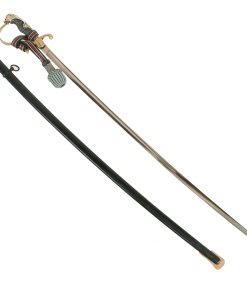Original German WWII Army Heer Officer’s Lion Head Sword by Clemen & Jung with Steel Scabbard & Troddel Knot Original Items
$ 650,00 $ 195,00
Original Item: Only One Available. This is a lovely classic Lionhead German WWII Army Officers sword, made by the somewhat rare firm of Clemen & Jung Waffenfabrik, of Solingen, Germany, complete with its original scabbard and a very nice leather and bullion troddel “sword knot”.
The hilt on this example is made from later war aluminum alloy, which was then gilt. We cannot tell if there is some type of plating between the gilding and the aluminum, or whether it was applied directly. It appears quite bright and “silver” looking in most areas, while the recessed areas less prone to wear are closer to the correct “gold”. There is no real oxidation visible on the bright portions of the hilt, so we believe that there is no brass plating under the gilding. The aluminum alloy hilt consists of a finely detailed lion head cat with engraved backstrap and “P” guard. The Lion is fitted with lovely blood red faceted “jewel” eyes, both of which are in fantastic condition. There is nice detail throughout his whiskers, chin, and muzzle. The handwork is beautifully rendered throughout the hilt. The backstrap, guard and side tabs bear lovely foliate and “star” designs, while the the grip ferrule bears the iconic German iconic German “Oak Leaves & Acorns” motif.
The cross guard has a spread winged eagle which looks to the viewer’s left. The breast area of this eagle, as well as the wings, have been hand-enhanced. The reverse langet is blank, without any plate where a monogram could be added. The hilt still retains some of the original gilt finish, with most areas worn down to the aluminum alloy base metal. The grip on this example is definitely interesting, as it looks to be a very late war type, made from zinc or aluminum alloy, which was then wire wrapped and finished. It has had much of the black finish wear away, and now shows a worn somewhat oxidized look.
The hilt is still mostly tight to the blade, with just a bit of wobble in the grip, which is a separate piece. The original leather blade buffer is missing from the base of the blade. There is a lovely leather and bullion officer’s troddel knot wrapped around the hilt, which is in very good condition, showing some wear to the finish on the leather. The strap has a lovely pattern of silver and red stripes on the black leather, which is replicated on the slider. The bottom knot is silver and green, and looks fantastic!
The 32 3/4 inch blade of this example is in very good condition, with the nickel plating retained almost completely. There are a few areas of minor oxidation and plating loss, probably the result of runner wear on the edge of the fuller. There is also some bending and denting to the last 1/2″ or so of the tip, but it can only be seen when closely examined. The edge is still correctly unsharpened, and does not show any dents or nicks.
The front of the blade under the langet is marked with “Crowned Z Shield” trademark of Clemen & Jung Waffenfabrik (Weapons Factory) of Solingen, the legendary “City of Blades” in the mountains of Western Germany. Unfortunately due to the angle there is no way for us to photograph this. This company was founded in 1860, and rapidly gained numerous domestic and foreign contracts for edged weapons. They entered the Solingen Commercial Register in 1876, and in 1898 registered the “Crowned Shield” logo, which has the letter Z inside the shield. This previously had been another makers trademark, but it was transferred to Clemen & Jung. The company supplied many edged weapons for the First World War, and continued during the interwar period, and into the Third Reich period. Army & Luftwaffe Officer daggers and swords are specifically noted for having the “Crowned Shield” on one side of the blade, with the address mark stamped on the other. For more information please see GERMAN KNIFE AND SWORD MAKERS by J. Anthony Carter, pages 132-134.
The scabbard of this example still has very good original factory black enamel, which is retained at about 90%. Sighting down the scabbard shows that it is straight, without any major dents or bends, making this really a great example. There is some chipping, scuffing, and moderate wear, but nothing out of line with service. It does not look to have been refinished at any time, and there is a lovely pattern of crazing and checking in the enamel, only possible after decades. In the past, for some reason the drag of the scabbard was painted gold, probably to hide oxidation and finish loss.
Overall a very good condition high quality sword from a well-known German sword maker, based in Solingen, the “City of Blades” in Western Germany. Ready to display!
Specifications:
Overall length: 38”
Blade length: 32 3/4″
Blade Style: Single Edged with Fuller
Guard dimensions: 5″ width x 5” length
Scabbard Length: 34″
The German Army (German: Heer, was the land forces component of the Wehrmacht, the German armed forces, from 1935 to 1945. The Wehrmacht also included the Kriegsmarine (Navy) and the Luftwaffe (Air Force). During World War II, a total of about 15 million soldiers served in the German Army, of whom about seven million became casualties. Separate from the army, the Waffen-SS (Armed SS) was a multi-ethnic and multi-national military force of the Third Reich. Growing from three regiments to over 38 divisions during World War II, it served alongside the army but was never formally part of it.
Only 17 months after AH announced publicly the rearmament program, the Army reached its projected goal of 36 divisions. During the autumn of 1937, two more corps were formed. In 1938, four additional corps were formed with the inclusion of the five divisions of the Austrian Army after the Anschluss in March. During the period of its expansion by Adolf AH, the German Army continued to develop concepts pioneered during World War I, combining ground (Heer) and air (Luftwaffe) assets into combined arms teams. Coupled with operational and tactical methods such as encirclements and the “battle of annihilation”, the German military managed quick victories in the two initial years of World War II, prompting the use of the word Blitzkrieg (literally lightning war, meaning lightning-fast war) for the techniques used.
The German Army entered the war with a majority of its infantry formations relying on the horse for transportation. The infantry remained foot soldiers throughout the war; artillery also remained primarily horse-drawn. The motorized formations received much attention in the world press in the opening years of the war, and were cited as the main reason for the success of the German invasions of Poland (September 1939), Norway and Denmark (April 1940), Belgium, France and Netherlands (May 1940), Yugoslavia (April 1941) and the early campaigns in the Soviet Union (June 1941). However their motorized and tank formations accounted for only 20% of the Heer’s capacity at their peak strength.
Fast Shipping with Professional Packaging
Thanks to our longstanding association with UPS FedEx DHL, and other major international carriers, we are able to provide a range of shipping options. Our warehouse staff is expertly trained and will wrap your products according to our exact and precise specifications. Prior to shipping, your goods will be thoroughly examined and securely secured. We ship to thousands clients each day across multiple countries. This shows how we're dedicated to be the largest retailer on the internet. Warehouses and distribution centres can be located throughout Europe as well as the USA.
Note: Orders with more than one item will be assigned a processing date depending on the item.
Before shipping before shipping, we'll conduct a thorough inspection of the items you have ordered. Today, the majority of orders will be delivered within 48 hours. The delivery time will be between 3-7 days.
Returns
The stock is dynamic and we cannot completely manage it because multiple stakeholders are involved, including our factory and warehouse. So the actual stock may alter at any time. It's possible that you may not receive your order once the order has been made.
Our policy is valid for a period of 30 days. If you don't receive the product within 30 days, we are not able to issue a refund or an exchange.
You can only return an item if it is unused and in the same state as the day you received it. You must have the item in its original packaging.
Related products
Uncategorized
Band of Brothers ORIGINAL GERMAN WWII Le. F.H. 18 10.5cm ARTILLERY PIECE Original Items
Uncategorized
Uncategorized
Uncategorized
Uncategorized
Uncategorized
Australian WWII Owen MK1 Machine Carbine SMG Custom Fabricated Replica with Sling Original Items
Uncategorized
Armored Burgonet Helmet & Polearm from Scottish Castle Leith Hall Circa 1700 Original Items
Uncategorized
Uncategorized
Uncategorized
Angolan Rebel 1970s era 60mm Inert Display Mortar from Angolan Civil War Original Items
Uncategorized
Armoured Fighting Vehicles of the World: AFVs of World War One (Hardcover Book) New Made Items
Uncategorized
Uncategorized
Uncategorized
Uncategorized
Uncategorized
Uncategorized
Uncategorized
Uncategorized
Uncategorized
Uncategorized
